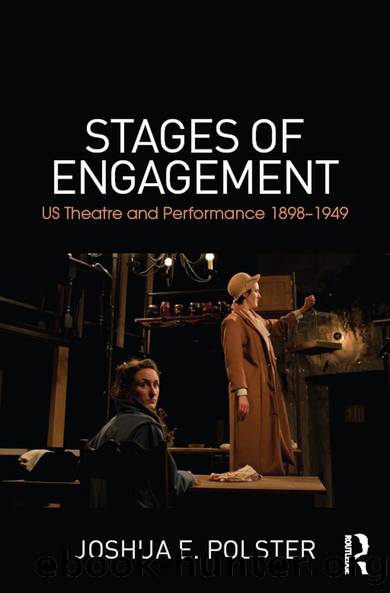Stages of Engagement by Joshua Polster

Author:Joshua Polster [Polster, Joshua]
Language: eng
Format: epub
Tags: History, North America, United States, General, 20th Century, Performing Arts, Theater, History & Criticism
ISBN: 9781317358732
Google: zdS9CgAAQBAJ
Publisher: Routledge
Published: 2015-10-16T16:11:51+00:00
Closing Arguments
In Patricia Bryanâs article for the Stanford Law Review, she writes about how the strategies invoked by the female characters in Trifles would never have worked for the Hossack murder case:
The idea of justifiable homicide by a wife was unthinkable, and denouncing either Mr. Hossack as a wife abuser or the community as having failed Mrs. Hossack would only have turned the all-male jury more strongly against her. And yet Susan Glaspellâs fiction suggests that, without considering those questions in determining responsibility and blame and without a fuller and more empathic understanding of the life of Margaret Hossack, justice was not done.
(1344)
Indeed, justice was not done. The court refused to relocate the trial, which made it difficult to find a group of male jurors who were unacquainted with John Hossack or were unprejudiced. The prosecution, as a result, successfully played on the male biases of the jurors (formed by societal concepts of female behavior â concepts that ironically helped to bring about the crime), and on the morning of April 11, 1901, they unanimously decided that Margaret Hossack was guilty. Five days later, she returned to court, where Susan Glaspell was undoubtedly present to hear Mrs. Hossack state to the judge, âBefore my God, I am not guilty,â and to witness the judge sentence Mrs. Hossack to the state penitentiary for life (1345). After the verdict, Mrs. Hossack was taken to prison by the sheriff. Accompanying them was the sheriffâs wife â the woman who had sat by Mrs. Hossack throughout the trial, and who would unknowingly become the inspiration for Glaspellâs heroine Mrs. Peters.
In Trifles, Glaspell illuminated the harsh life of married women in a complicit society, and their limited options to redress injustices by abusive men in an indifferent judicial system. Moreover, she presented a space of feminist resistance where â despite male opposition â women were visible and heard. In this space, she showed the necessity for women to resist gendered laws inefficiently and unfairly administered by men, the necessity for women to be engaged in their justice, as well as the necessity to develop the critical skills to administer justice effectively. Moreover, Glaspell presented in her play the struggle for women to have equal protection, representation, and presence before the law, a right, as it turned out, which was not immediately won with the Nineteenth Amendment. As Sophie Treadwell demonstrated in Machinal â a play written after the Nineteenth Amendment â women were still unjustly tried in court and unable to have a jury of their peers. Suffragists believed that after the enactment of the Nineteenth Amendment their new status as voting citizens would secure their place as equal citizens and grant them other rights, such as the right to serve on juries. However, their ability to have equal representation before the law â in the courtrooms and legislation â continued to be challenged and debated.32 In Trifles, Glaspell gave recognition to this long struggle for womenâs civil rights, and helped to provoke and prepare
Download
This site does not store any files on its server. We only index and link to content provided by other sites. Please contact the content providers to delete copyright contents if any and email us, we'll remove relevant links or contents immediately.
Verus Israel: Study of the Relations Between Christians and Jews in the Roman Empire, AD 135-425 by Marcel Simon(574)
Phoenicians among Others: Why Migrants Mattered in the Ancient Mediterranean by Denise Demetriou(573)
Caesar Rules: The Emperor in the Changing Roman World (c. 50 BC â AD 565) by Olivier Hekster(555)
Europe, Strategy and Armed Forces by Sven Biscop Jo Coelmont(503)
american english file 1 student book 3rd edition by Unknown(472)
Give Me Liberty, Seventh Edition by Foner Eric & DuVal Kathleen & McGirr Lisa(469)
Banned in the U.S.A. : A Reference Guide to Book Censorship in Schools and Public Libraries by Herbert N. Foerstel(467)
The Roman World 44 BC-AD 180 by Martin Goodman(457)
Reading Colonial Japan by Mason Michele;Lee Helen;(456)
Basic japanese A grammar and workbook by Unknown(450)
DS001-THE MAN OF BRONZE by J.R.A(442)
The Dangerous Life and Ideas of Diogenes the Cynic by Jean-Manuel Roubineau(436)
Introducing Christian Ethics by Samuel Wells and Ben Quash with Rebekah Eklund(432)
Imperial Rome AD 193 - 284 by Ando Clifford(431)
The Oxford History of World War II by Richard Overy(431)
Literary Mathematics by Michael Gavin;(392)
Language Hacking Mandarin by Benny Lewis & Dr. Licheng Gu(378)
Catiline by Henrik Ibsen--Delphi Classics (Illustrated) by Henrik Ibsen(364)
How to Reach the 9.0 in IELTS Academic Reading by IELTS Medical(357)
